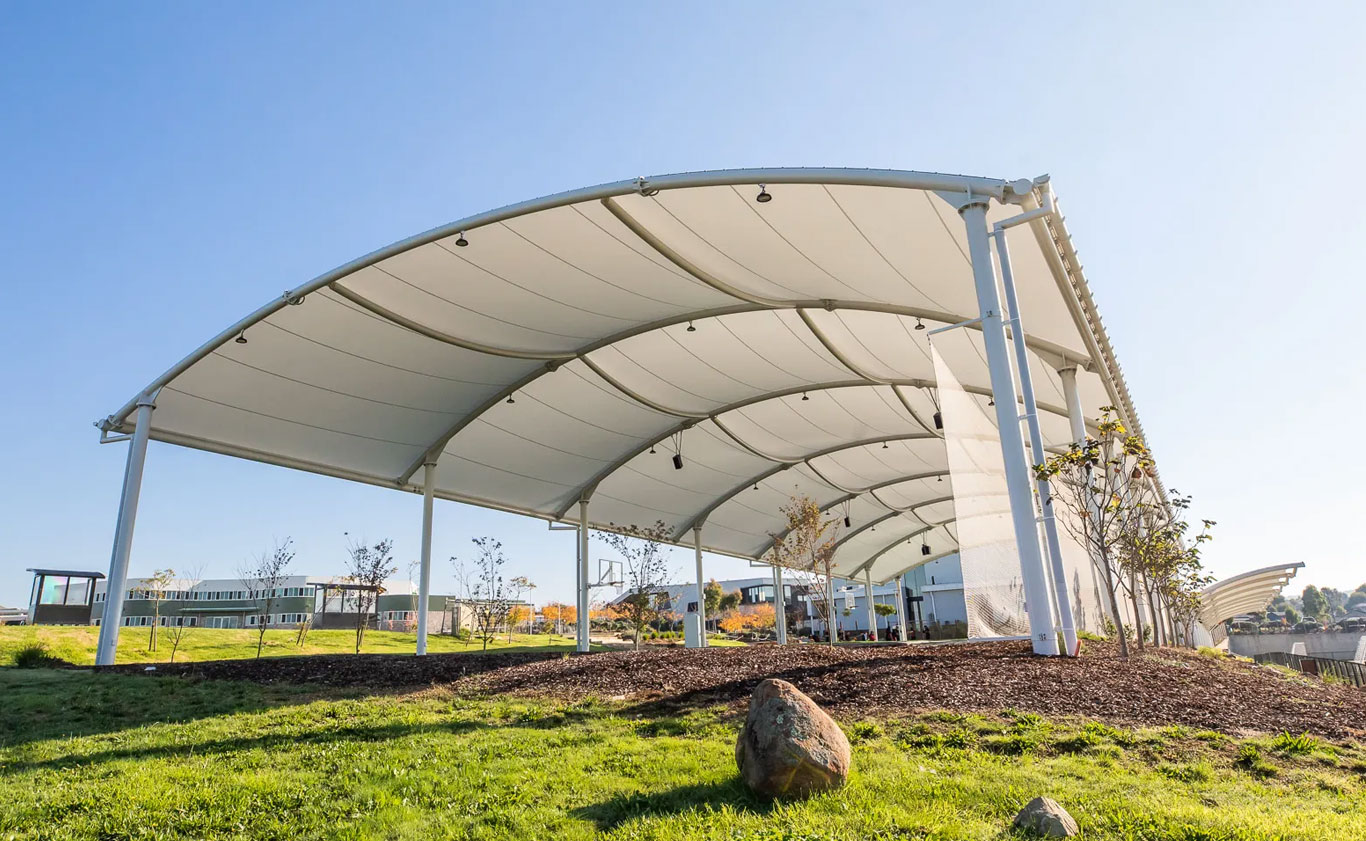
Types of Tensile Fabric and Structure
 The tensile membrane structure is the term usually used to refer to the construction of roofs using a membrane held in place on steel cables. It is the form of structure that is carrying only tension, eliminating compression or bending. Most tensile structures are supported by some form of compression or bending elements. Tensile structures are the most common type of thin-shell structures.
The tensile membrane structure is the term usually used to refer to the construction of roofs using a membrane held in place on steel cables. It is the form of structure that is carrying only tension, eliminating compression or bending. Most tensile structures are supported by some form of compression or bending elements. Tensile structures are the most common type of thin-shell structures.
Tensile structures have been in use since ancient times. The most rudimentary applications could be seen in the form of tents and other temporary roofing used by nomadic tribes. These structures exhibit nonlinear behavior as opposed to linear relationships observed in conventional structures which use steel as its primary material resource. The non-linear relationship can be observed in geometry as well as in material aspects.
A tensile membrane structure is most often used as roofs as they can economically and attractively span large distances. Tensile membrane structures may also be used as complete buildings with a few common applications such as sports facilities warehousing and storage buildings and exhibition venues.
The most popular types of tensile fibers are:
- 1. PVC Coated Polyester
- 2. PTFE Coated Glass Cloth
- 3. ETFE
PVC Coated Polyester:
PVC coated polyester can be a great material choice for both permanent and temporary tensile fabric structures. PVC coated polyester is known for its excellent strength, flexibility, translucency and affordability compared to PTFE coated glass cloth and ETFE. The PVC coating which is applied to polyester includes UV stabilizers, fire retardant additives and anti-fungicides. PVC coated polyester fabrics have a structural lifespan greater than 20 years.
PTFE Coated Glass Cloth:
PTFE coated glass cloth was developed by DuPont in the 1960s and has been used to create tensile fabric structures since the early 1970s. Originally, the material had a lifespan of 25 years; however, this has already been exceeded with present day expectations lying somewhere between 30 and 50 years.
ETFE:
While ETFE is a film rather than a fabric, it is worth touching on because it is commonly used as an alternative to structural glass and is rapidly growing in its applications. ETFE is an excellent choice if thermal insulation is a priority of your project.
Types of Tensile Structures
There are three types of tensile structures
Linear tensile structures are the structure in which all the members are in linear tensile forces. These linear members are supported by the compression members but the major loads are carried out by tensile members. A common example of this structure is cable-suspended bridges. The main pillars act as compression members but the whole load is carried out by the cables which are in tension.
Three-dimensional tensile structures is a compilation of elements that are primarily in tension with the compression being transferred to a central mast and down into the ground. The most common occurrence of three-dimensional tension can be seen at sports arenas and usually serve as roofs for these structures.
Surface-stressed tensile structures are the same as other 2 tensile structures, but the surface members are tension bearing members. Fabric tensile structures are the great examples of Surface-stressed tensile structures where the vertical pillars hold the specially designed fabric which is in tension.
Know More About - Tensile Membrane
- Types of Tensile Fabric and Structure
- Feature of Tensile Membrane
- Properties of Tensile Membrane
- Application of Tensile Membrane
- Advantages of Tensile Membrane
- Characteristics of Tensile Membrane Structure
- Types of Fabric Material for Tensile Structures
- Factors Affecting Performance of Membrane Structures
FAQ's
- The latest applications of tensile Fabrics include
- Building Envelopes:
- Amphitheaters:
- Passenger Transport - Oriented Designs
- Airport Canopies
- Stadiums & Athletic Facilities
- Interior
Get Your Free Quote Today!
Tell us about your project needs and we'll provide a custom quote tailored to your specific requirements.
